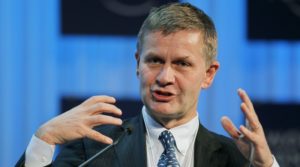Minamata Convention: One year progress of making mercury history
Picture caption: Delegates at the COP1 of Minamata Convention on Mercury held in Geneva, Switzerland in September 2017.
By Kayode Aboyeji
It is exactly one year today Thursday August 16, 2018 that the Minamata Convention on Mercury, the world’s first legally binding global agreement to reduce mercury pollution, becomes international law. The milestone was achieved 90 days after it exceeded the threshold of 50 countries that ratified it in August 2017.
The Governing Council of United Nations Environment Programme (UNEP) had in February 2009 adopted Decision 25/5 on the development of a global legally binding instrument on mercury. However, following the conclusion of the negotiations at the fifth session of the Inter- governmental Negotiating Committee (INC5), the text was adopted and opened for signature at a Diplomatic Conference (Conference of Plenipotentiaries), held in Kumamoto, Japan from 10 to 11 October 2013, with a ceremonial opening in Minamata on October 9 same year.
Specifically, the objective of the Convention is to protect human health and the environment from anthropogenic emissions and releases of mercury and mercury compounds by measures: to control the supply and trade of mercury; to control mercury- added products and manufacturing processes including artisanal and small scale gold mining; on the environmentally sound interim storage of mercury and on mercury wastes on contaminated sites.
Since it became legally binding in 2017, all hands by governments, non-governmental organisations, development agencies, professionals and other stakeholders have been on the deck to develop policies, programmes and create awareness across the globe on the dangers of mercury to human and physical environment and to make mercury history.
Minamata COP1
The first meeting of the Conference of the Parties to the Minamata Convention on Mercury (COP1) took place from 24 to 29 September 2017 in Geneva, Switzerland.
The Conference culminated in a High-Level Segment hosted by the President of Switzerland, entitled “Make Mercury History”, to celebrate the commitment of the international community to the Minamata Convention.
Amongst its main outcomes, COP1 agreed on a programme of work and budget for the secretariat, and adopted decisions on guidance to the Global Environment Facility (GEF), activities of the Specific International Programme, administrative matters relating to the Conference of the Parties, and on guidance on trade in mercury, stocks and sources of supply of mercury, exemptions, artisanal and small-scale gold mining and emissions.
COP1 also adopted decisions relating to intersessional work, particularly on effectiveness evaluation, interim storage of mercury other than waste mercury, mercury wastes and contaminated sites. Delegates also elected officers that would form the Bureau until the conclusion of COP2
COP1 culminated on 28 and 29 September 2017 in a High-Level Segment hosted by the President of Switzerland, entitled “Make Mercury History”, to celebrate the commitment of the international community to the Minamata Convention. Read the summary of “key Take-Home messages” provided by the President of the Conference.
During COP1, specific consideration was paid by delegates to health rights of indigenous communities, through the consideration of whole lifecycle of mercury, from its supply, management and trade.
State Parties also supported Switzerland’s proposal to accommodate the Permanent Secretariat in Geneva while there was emphasis on the need for greater protection of infants and unborn children.
Besides these, several other key decisions were reached by delegates during the week-long meeting in Geneva.
Appointment of Executive Secretary
In May 2018, the Executive Director of UNEP appointed Rossana Silva-Rapetto, on a temporary basis, as the Executive Secretary, pending permanent arrangements to be agreed upon regarding the Secretariat of the Convention. Similarly, the Secretariat has also created three trust funds established by the Parties to support the activities of the Convention.

Reactions on one year of entry into force of Minamata Convention
To celebrate the one year anniversary of entry into force of Minamata Convention on Mercury, Ecogreen News with the support of President of World Alliance for Mercury-Free Dentistry, Charlie Brown received email comments from the Executive Director of UNEP, Erik Solheim and other stakeholders across the world as reported below.
Executive Director, United Nations Environment Programme, Erik Solheim said, “The Minamata Convention is the world’s newest environmental agreement, and a lot is at stake. Mercury is far more pervasive than most people realize, and everyone is at risk when it is released without safeguards. We must stop the use of mercury in gold mining; end mercury mining and phase out mercury containing products. By doing so, we will have made significant progress in protecting human health and the environment.”
European Union coordinator, World Alliance for Mercury-Free Dentistry, Florian Schulze said, “Thanks to the Minamata Convention the European Union had to move together and find a common solution. Since some countries like Sweden, Norway or Denmark had already banned amalgam, the European Union decided to go beyond the requirements of the Minamata Convention and banned the use of amalgam for children up to the age of 15 years and pregnant and breastfeeding women in a first step. In a second step other European countries are encouraged to follow the Scandinavian examples and in a third step the European Union is considering a general ban in 2030, but the very common use of alternatives shows that there is already now no more need of amalgam in modern dentistry! We should not wait any longer!
Coordinator, Latin American Centre for Environmental Health, María Isabel Cárcamo , said, “Latin American and the Caribbean countries are working towards the elimination of the dental amalgams, 80 % of them, have already ratified the Minamata Convention. Our region is very much aware of the health concerns, especially to the exposure to mercury of vulnerable populations, especially women, children, and, through them, future generations. During the negotiation of the Convention, the region has promoted an article on health, which was included in the letter of the Convention. It should be noted that the Minamata Convention is the only agreement that has an article on health, thanks to the GRULAC region.”
Similarly, President, World Alliance for Mercury-Free Dentistry, Attorney Charlie Brown said, ‘The Minamata Convention will “make dental amalgam . .. history.” The world will send to the ash heap of history this primitive colonial-era pollutant that damages teeth, puts mercury into fish which children eat, causes neurological harm to dental workers, and poses such a huge risk to human health. The World Alliance for Mercury-Free Dentistry is adamant that all boats shall rise together – we must end dental mercury use simultaneously: as we phase out amalgam in Europe and North America, we do the same in Asia, Africa, Latin America, and Island States.’
Coordinator, Asian Centre for Environmental Health, Siddika Sultana said “Asia is moving towards Mercury Free Dentistry! We set up our goal “to protect future generation “Environment and Public Health by Ending Amalgam Use” . Asia is the largest continent in the world. We suffer natural calamities and pollution in many folds. Mercury emission and pollution particularly the amalgam pollution is high cost for Asia as well as other continent. We work together with the Govt, Dental Professionals, Civil Society and Academicians to Eliminate Mercury Dental Amalgam by setting to date line “Stop using dental amalgam for children and pregnant mother between 2018-2020. So, lets come forward to work together to achieve our common goal.
President of the African Centre for Environmental Health and vice president for Africa, World Alliance for Mercury-Free Dentistry, Dominique Bally, said “The Minamata Convention, which entered into force last year, brings hope for Africa region. As a major consumer of mercury added-products, Africa pledged to strengthen the text of the convention on its article related to products. As the region that generated the Minamata Convention blueprint on dental amalgam — phase down in use with steps specified – Africa has begun the transition to mercury-free dentistry. For Africa, “making mercury history” starts with “making amalgam history,” specifically, its immediate end for children, pregnant women and nursing mothers.”
Executive Director, Sustainable Research and Action for Environmental Development (SRADev Nigeria), Dr. Leslie Adogame, said “The first year of Minamata convention in Nigeria has been of remarkable success. Nigeria government has pledged political support by ratifying the Convention in February 2018. First of all, Nigeria was the first country to complete its Minamata Initial Assessment (MIA) report in readiness for implementation.
“Beyond, committed efforts are on towards domesticating the Convention in that the key agencies of government NESREA and NAFDAC are already in the process of domesticating key components of the Convention by formulating regulations that will manage the ban of mercury added products (MAP) manufacture, export, import and use by 2020. The Federal Ministry of Health is also setting the pace in finalizing the National Policy for the Phase down and eventual phase out of Dental Amalgam use in Nigeria. These are key milestones that demonstrate that Nigeria is a key world leader in the first year of the Minamata Convention”.
As of the time it entered into force in 2017, only 74 nations ratified the Convention. But the number of ratification has continued to increase as 21 Parties have joined the treaty as at August 15, 2018.
Within the last one year, efforts are being made by nations and groups to make mercury history. Of note are the activities of the World Alliance for Mercury-Free Dentistry that has been working assiduously to phase-down dental amalgam, one of the sources of mercury in the environment.
The group had organised separate synergistic campaigns in Africa, working with the African Center for Environmental Health; in Asia, working with the Asian Center for Environmental Health; and in Latin American, working with the Latin American Center for Environmental Health and co-funded, with local people within the regional centers.
WAMFD also has a strong campaign at the European Union and in many of its member states (e.g. Germany, Poland, Spain); in the US , Canada; and in Oceania. Late last year, a maiden stakeholder’s summit was held in Edo State, South-South Nigeria on ending use of dental amalgam. In May 2018, a global workshop organised by WAMFD in conjunction with UNEP was held in Bangkok, Thailand while in July another national summit for developing phase-down policy on ending dental amalgam was held in Abuja, Nigeria capital city and a stakeholder’s conference in Togo, within the same week.
Meanwhile, the second meeting of the Conference of the Parties (COP2) to the Minamata Convention on Mercury will take place from 19th – 23rd November, 2018 in Geneva, Switzerland.




